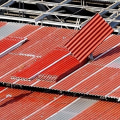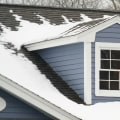In reality, tar can be used on a metal roof, and many people place the black goop in valleys, ceiling-to-wall joints, and plumbing vents to prevent or stop leaks, says William Kibbel III, a home inspector and restoration consultant who serves as vice president of Tri-County Inspection Co. Yes, tar can be applied to a roof at temperatures as low as 40 degrees Fahrenheit. However, it will not dry or seal properly until the temperature is at least 70 degrees. Also, never apply tar when it is very hot, for example, in the middle of summer.
Warm temperature can cause tar to drip and make an incredibly sticky mess. A very common place for metal roofs to leak is around pipe burrs and around HVAC units. A very common repair method in Indiana is to apply more caulking, tar, or roofing metal coating around the leaking flashing. Applying the right sealant to the right spots can, in fact, stop the leak, but taking the most approach is better with tar or sealant and is likely to create a water dam behind the flashing.
Too much sealant around the flashing can cause water to stagnate behind the flashing and worsen leakage Avoid trapping water by not filling the entire metal roof tray with fresh sealant. Unfortunately, what you're doing is putting a band-aid on an open wound. And while band-aids can be useful, they are also temporary. In a fairly short period of time, the tar on the roof will begin to dry out and crack.
These cracks will now open your roof to the same leak it originally had, only now you have an additional problem. Homeowners should always consult with a roofing expert or quality contractor before starting any roofing project. Before applying any product to your ceiling, a professional will need to check for structural damage. If your roof is structurally solid, go up with a broom, a long-handled paint roller, roofing tar and a disposable container.
If the sealant on the bottom of the roof holds, it can cause water to accumulate behind it and force it into the house or building. Learning how to apply roofing tar is quite simple, although homeowners should consider hiring a contractor to do this dirty work. Apply butyl tape and waterproof roofing putty on each seam to ensure long-lasting, water-repellent protection. If the cost of roof repair really bothers you, consider making your own temporary repair by placing a tarp over the roof or cutting some sheets of metal into shingles and using them to patch the roof.
Water penetration can cost homeowners a lot of money when the seams of metal roofing sheets have not been properly sealed. You will also know if this is a leak from a bad roof detail or an installation problem that was repeated in other parts of the roof, whether it is a material failure that you may know in the future, or if it is a single leak from a puncture or third-party damage. A second reason why surface caulking is not the best idea in the valley on metal roofs is that once you start sealing a valley, you need to ensure that it remains completely sealed from top to bottom from that point on and that is almost impossible to do. Using the right type of metal roof sealant is just as important as finding the leaking screw or the leaky lap.
Clean corrosion patches vigorously with a wire brush until all scale is removed, then sweep away loose corrosion and other debris from the roof. .










